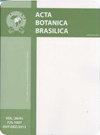Pollen morphology of the early branching papilionoid legume genera Harleyodendron, Holocalyx and Uribea
IF 1.1
4区 生物学
Q4 PLANT SCIENCES
引用次数: 0
Abstract
In this study, pollen grains of Harleyodendron unifoliolatum , Holocalyx balansae , and Uribea tamarindoides , three monospecific genera with Neotropical distribution belonging to the clade Exostyleae, one of the basal lineages of the family Leguminosae, subfamily Papilionoideae, were analyzed. The palynological material was acetolyzed and analyzed under light microscopy (LM) and scanning electron microscopy (SEM). Under LM, small and medium-sized pollen grains were observed, which showed a prolate-spheroidal to prolate shape, 3-colporate, microreticulate and reticulate exine, sexine and nexine of equal thickness in Harleyodendron and Holocalyx , while the sexine was thicker than nexine in Uribea . Analysis under SEM showed finely granulate, psilate, and granulate apertural membrane, while the exine ornamentation varied from perforate-microechinate in Harleyodendron , to perforate in Holocalyx , while in Uribea showed an irregular relief and granular projections on the perforate tectum. The pollen morphology of these species is similar to each other, varying in sexine/nexine ratio, apertural membrane, and exine ornamentation. Harleyodendron has a finely granulate apertural membrane, sexine and nexine of equal thickness, and a perforate-microreticulate exine ornamentation, Holocalyx shows a psilated apertural membrane, sexine and nexine of equal thickness, and exine ornamentation perforate, and Uribea has a granulate apertural membrane, sexine thicker than nexine, and exine ornamentation with granular projections.早期分枝的凤尾花属豆科植物——杂交菜属、全新花属和乌兰属的花粉形态
本文章由计算机程序翻译,如有差异,请以英文原文为准。
求助全文
约1分钟内获得全文
求助全文
来源期刊

Acta Botanica Brasilica
PLANT SCIENCES-
CiteScore
2.30
自引率
9.10%
发文量
32
审稿时长
6-12 weeks
期刊介绍:
Experimental, theoretical and applied papers on all aspects of plant (including algae) and fungi biology are welcome. The submitted manuscript or its essential content must not have been published previously or be under consideration for publication elsewhere. Contributions should be substantial, written in high-quality English and show general interest. We expect that the submitted manuscript presents a great novelty in Botany, and this should attract a wide audience. Considering this, case studies are only considered if the narrative and implications are provided to be of general interest. Thus, manuscripts that report aspects of local interest are discouraged unless the implications of the findings are wide-reaching. Manuscripts with agronomic subjects are expected to contain a substantial amount of basic plant biology. Please see below some details for specific area.
 求助内容:
求助内容: 应助结果提醒方式:
应助结果提醒方式:


